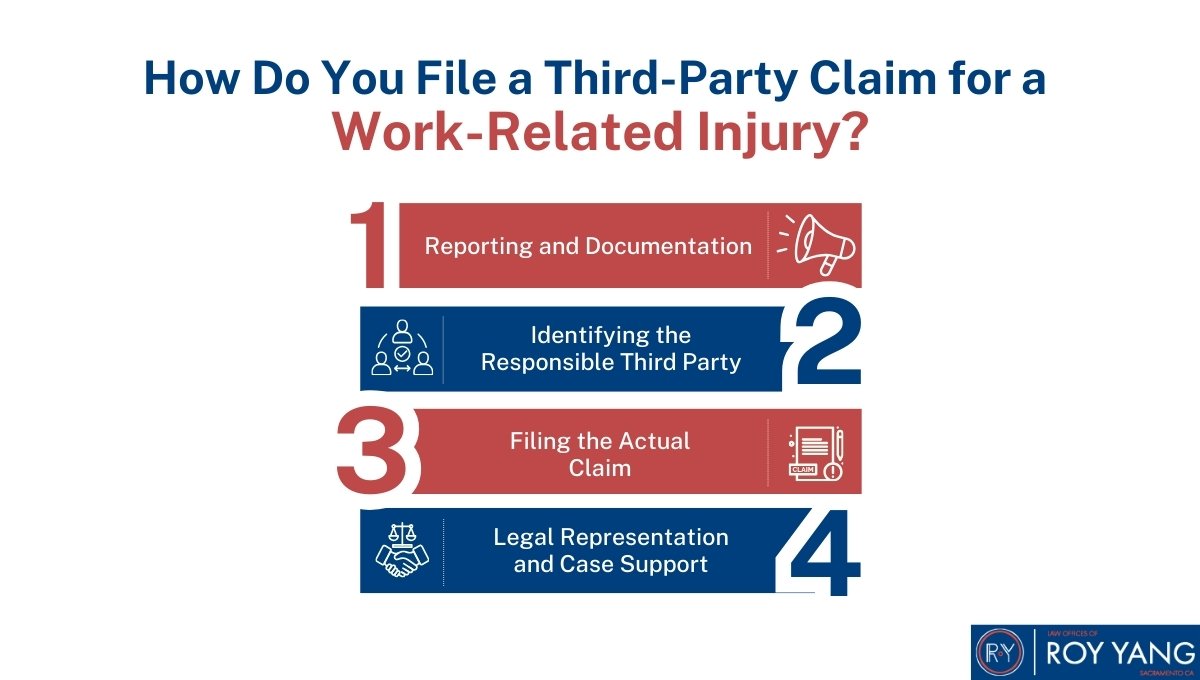A third party claim is a legal action filed by an injured worker against someone other than their employer who is responsible for the negligence that caused their injury. Examples of non-employer claim targets include subcontractors, drivers, and equipment managers. Unlike workers’ compensation, a third party claim allows the injured worker to pursue full compensation, including pain and suffering, lost wages, and other damages not covered by workers’ comp.
Identifying when third-party liability exists starts with understanding who had control, who created the hazard, when to apply, and who had a duty to keep you safe.
Key Takeaways
- Third-party claims apply when someone other than your employer causes your work injury.
- You must prove the third party was at fault to recover full compensation.
- These claims can cover pain, suffering, full lost wages, and future earnings.
- Strict deadlines apply; California allows 2 years to file a claim.
- Detailed, cohesive proof via documentation is essential to support your case.
- Legal representation improves outcomes and avoids costly mistakes.
When Does Third-Party Liability Apply at Work?
Third-party liability applies when someone outside your employer’s control causes your injury, and that party owed a duty to keep you safe. This includes subcontractors, vendors, drivers, equipment manufacturers, or property owners whose negligence created the hazard that led to your injury.
Understanding how this plays out starts with three common scenarios where third-party liability exists:
Faulty Equipment Injuries
Defective tools or machines can lead to serious work injuries and third-party claims. Broken ladders, failing safety harnesses, or unstable scaffolding are common causes. In these cases, the manufacturer or supplier can be held legally responsible for unsafe products.
Injuries from Subcontractors or Vendors
Job sites often include subcontractors, delivery crews, or maintenance workers who are not part of your company. If one of them causes an accident, for example, dropping materials or leaving hazards, they can face liability for your injuries.
On-Premise Third-Party Property Accidents
Injuries that happen on property not controlled by your employer may involve third-party fault. Rented office spaces, shared facilities, or client sites must be kept safe. Property owners who ignore dangers can be named in a separate injury claim.
Third-Party Claims vs. Workers’ Compensation: Key Differences
A third-party claim requires proof that someone other than your employer caused your injury, while workers’ compensation pays benefits regardless of fault but limits the type of compensation you can receive.
The table below outlines the key differences between third-party claims and workers’ compensation, helping you understand how each option impacts your rights, compensation, and legal process.
| Attribute | Fault Requirement | Compensation Scope | Right to Sue | Legal Process | Timeline | Employer Involvement |
|---|---|---|---|---|---|---|
| Third-Party Claim | Yes – Must prove third-party negligence | Full damages, including pain and suffering | Can sue liable third parties | Civil litigation with multiple parties | Longer and varies based on case complexity | Not involved as a defendant |
| Workers’ Compensation | No – Benefits paid regardless of fault | Limited to wage loss and medical bills | Cannot sue the employer | Administrative process through an employer | Typically faster and standardized | Pays benefits directly or via insurer |
What Can You Recover in a Third-Party Claim?
A third-party claim allows you to recover compensation beyond what workers’ comp provides. Unlike workers’ compensation, these claims let you pursue the full value of your losses, including kinds of harms that can not be measured in bills alone.
You may recover:
- Pain and Suffering: For the physical pain and emotional stress caused by the injury.
- Full Lost Wages: Not just partial disability pay, but your total missed income.
- Loss of Future Earnings: If your injury affects your ability to work long-term.
- Punitive Damages: In rare cases, if the third party acted recklessly or intentionally.
- Out-of-Pocket Costs: Travel to medical appointments, home care, and other uncovered expenses.
These claims can result in higher payouts because they consider how your life has changed, not just the cost of your bills.
How Do You File a Third-Party Claim for a Work-Related Injury?
Filing a third-party claim involves both paperwork and legal action. You will need to follow several steps to build a strong case and meet all legal deadlines.
Reporting and Documentation
Start by reporting the injury to your employer and writing down everything. Take photos, save medical records, and note witness names. Most states have strict deadlines, and missing them can hurt your claim.
Identifying the Responsible Third Party
Identify who caused the injury outside your job. This could be a contractor, equipment company, or property owner. Accurately analyzing who is responsible is key before filing a third-party claim.
Filing the Actual Claim
Prepare documents like medical records, incident reports, and evidence of lost wages. You will need to file these with the proper court or agency, depending on your state. Each jurisdiction has different rules and workers’ comp claim forms(DWC-1).
Legal Representation and Case Support
A lawyer can help gather strong evidence, file legal documents, and handle negotiations. If the third party denies fault or offers a low settlement, an attorney can take the case to court and fight for full compensation.

Why You Need a Lawyer for a Third-Party Work Injury Claim?
Third-party claims come with serious legal risks that can reduce your payout. Proving fault, dealing with insurance companies, and missing deadlines can all hurt your case.
We have prior experience handling every one of these hurdles. Here is what to expect:
Proving Third-Party Fault
You need strong evidence to show the third party caused your injury. Photos, witness statements, and job site records help prove negligence. A lawyer knows how to gather and present this technical evidence.
Dealing with Multiple Insurance Parties
Third-party claims in California often involve more than one insurance company. A lawyer coordinates between the workers’ compensation insurer and the third-party carrier. This helps avoid payout delays and claim mistakes.
Navigating Filing Deadlines and California Rules
California law gives you two years to file a third-party claim after the injury. Missing this deadline can cancel your right to sue. A lawyer ensures that all legal steps are taken on time and in accordance with state rules.
You’ve already been through enough. Let’s take the legal stress off your shoulders. We will review your situation, explain your options, and help you protect what matters most: your health, your income, and your future.
How Third-Party Insurance Claims and Settlements Work?
Once a third-party claim is filed, it enters a negotiation phase where timing, tactics, and evidence shape the outcome. What happens next depends on factors such as who handles your case, the strength of your proof, and how clearly fault can be established.
Insurance Adjuster Role and Strategy
Adjusters are trained to protect the insurance company, not you. They often downplay injuries, delay communication, or make early low offers. Some requests are missing or incomplete records to reduce your payout.
Typical Timelines for Settlement
Most third-party claims in California take 3 to 18 months to settle. Cases with clear fault and full documentation often resolve within the first year. If the claim goes to trial, expect another 6 to 12 months, depending on the court’s schedule.
Payout Factors and Examples
Your settlement amount depends on three key factors:
- Injury Severity: A fractured spine brings higher compensation than soft-tissue injuries.
- Clarity of Fault: Video or witness proof of the third party’s mistake increases the claim’s strength.
- Documentation Quality: Medical records, written statements, and proof of lost income support a full payout.
Legal Risks of Handling a Third-Party Claim Alone
Managing a third-party claim without legal help often leads to time wasted and costly mistakes. Here are the most common errors injured workers make when they go it alone:
- Missing Deadlines: California law sets strict time limits. Filing late can cancel your case.
- Giving Recorded Statements: Insurers will try to use your words against you to deny or reduce your claim.
- Undervaluing the Injury: Many victims accept low offers without knowing what their case is really worth.
- Failing to Identify the Right Party: Suing the wrong business or individual can delay your claim or cause it to be thrown out.
- Incomplete Documentation: Missing medical records, wage details, or incident reports weaken your claim.
- Settling Too Early: Some injuries can worsen over time. Settling fast can leave you with unpaid bills.
Negotiate or Litigate – Take Help From the Law Offices of Roy Yang
Every third-party claim reaches a turning point – settle or go to court. The right choice depends on the facts, the offer on the table, and the long-term impact of your injury. We help you make that call and back it with proven legal strategy.
At the Law Offices of Roy Yang, we bring:
- Over 15 years of focused experience in California Workers’ Compensation and third-party injury claims
- A case strategy built on results, not shortcuts, because every detail affects how you recover
- Relentless diligence and personal attention to every client we serve
You don’t pay unless we win. Our work is 100% contingency-based, No Fees upfront, no surprises later.
We don’t just file paperwork: we help you build a path to justice by protecting your rights and fighting for the compensation you deserve.
Need honest legal support, not added pressure? Contact us – we’re ready when you are.
Key Takeaways Before You File a Third-Party Claim
Here’s what to remember before starting a third-party claim for a work-related injury:
- You Must Prove Fault: Unlike workers’ compensation, third-party claims require showing that someone else caused the injury.
- You Can Recover More: These claims cover full wage loss, pain and suffering, and future earnings.
- Documentation Is Critical: Photos, medical records, witness names, and incident reports all strengthen your case.
- There Are Strict Deadlines: In California, you have two years to file most third-party claims.
- Legal Help Matters: A lawyer can handle negotiations, deal with insurers, and protect your rights.
- Not All Injuries Qualify: You can not sue your employer, but you can file against outside parties like vendors, contractors, or property owners.



